|
|
|
Sort Order |
|
|
|
Items / Page
|
|
|
|
|
|
|
| Srl | Item |
| 1 |
ID:
122443
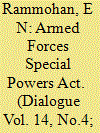

|
|
|
|
|
| Publication |
2013.
|
| Summary/Abstract |
On the 11
th
of July 2004, the personnel of the Assam Rifles picked up a
young woman from her house in Thoubal district at about 2300 hours.
Her house was searched but nothing was found. The Assam Rifles
personnel then arrested her and left after leaving an arrest memo stating
that they had not found anything incriminating. The next morning her
body was found on a nearby hillock with several bullet injuries around
her waist and abdomen. The local people who found her body naturally
thought that she had been raped. This was followed by the extraordinary
spectacle of a group of middle aged and elderly women leading a
march to the gate of the Assam Rifles and disrobing themselves
demanding that they should be raped. The valley then exploded in a
violent agitation that lasted more than a month. Regrettably the reaction
from the Centre was most unsympathetic. The statements made by
some senior officials were particularly insensitive. One stated that the
lady, Thangjom Manorama was a PLA cadre and she was an explosives
expert and several security personnel had been hurt and killed by her
explosive devices. This seemed to imply that her killing was justified.
|
|
|
|
|
|
|
|
|
|
|
|
|
|
|
|
| 2 |
ID:
145816
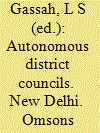

|
|
|
|
|
| Publication |
New Delhi, Omsons Publications, 1997.
|
| Description |
xi, 350p.hbk
|
| Standard Number |
8171171540
|
|
|
|
|
|
|
|
|
|
|
|
Copies: C:1/I:0,R:0,Q:0
Circulation
| Accession# | Call# | Current Location | Status | Policy | Location |
| 058702 | 352.264/GAS 058702 | Main | On Shelf | General | |
|
|
|
|
| 3 |
ID:
186300
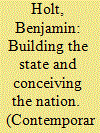

|
|
|
|
|
| Summary/Abstract |
In 1966 the Mizo National Front (MNF) instigated a separatist conflict against the Indian state. This article argues that an environment conducive for separatist insurgency was created by the early 1960s in the Mizo Hills, a direct result of problematic state- and nation- building practices. First, there was an inability to initiate a successful state-building drive to overcome deep-seated challenges bestowed by colonial rule. Second, the friction between regional and national conceptions of identity was not resolved. This argument exploits a clear research gap. Currently there is a convincing explanation for the MNF’s transition towards civil war between 1961-66. Yet, explaining the structural factors which created an environment conducive for separatist conflict remains elusive. This article plugs that gap, through archive-led historical analysis. In the process, it provides wider insights for conflict dynamics in India’s northeast and raises broader questions about interdisciplinary research in the subfield of intrastate conflict.
|
|
|
|
|
|
|
|
|
|
|
|
|
|
|
|
| 4 |
ID:
108213
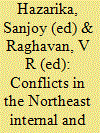

|
|
|
|
|
| Publication |
New Delhi, Vij Books, 2011.
|
| Description |
xi, 116p.
|
| Standard Number |
9789381411124, hbk
|
|
|
|
|
|
|
|
|
|
|
|
Copies: C:1/I:0,R:0,Q:0
Circulation
| Accession# | Call# | Current Location | Status | Policy | Location |
| 056315 | 303.690954/HAZ 056315 | Main | On Shelf | General | |
|
|
|
|
| 5 |
ID:
176640
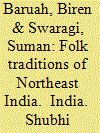

|
|
|
|
|
| Publication |
India, Shubhi Publications, 2019.
|
| Description |
137p.Hbk
|
| Standard Number |
9788182903074
|
|
|
|
|
|
|
|
|
|
|
|
Copies: C:1/I:0,R:0,Q:0
Circulation
| Accession# | Call# | Current Location | Status | Policy | Location |
| 059954 | 398.09541/BAR 059954 | Main | On Shelf | General | |
|
|
|
|
| 6 |
ID:
091489
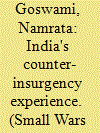

|
|
|
|
|
| Publication |
2009.
|
| Summary/Abstract |
The Indian Army, a force trained primarily for conventional warfare, has been engaged in internal counter-insurgency operations since the 1950s. Despite such a long innings on a counter-insurgency mode, little attention has been accorded within military circles to doctrinal innovation for waging sub-conventional warfare in India's democratic political context. At best, the Army continues to view counter-insurgency duty as secondary to its primary duty of defending India from external conventional threats. By conceptualizing a counter-insurgency strategy of 'trust and nurture', this article aims to fill this critical doctrinal gap in India's military policy. The author argues that a counter-insurgency strategy of 'trust and nurture' based on democratic political culture, measured military methods, special counter-insurgency forces, local social and cultural awareness and an integrative nation-building approach will result in positive handling of India's internal security problems. The author utilizes India's counter-insurgency experiences in Assam, Mizoram, Nagaland, Punjab, and Operation 'Sadhbhavana' in Jammu and Kashmir as illustrative empirical indicants in order to validate the 'trust and nurture' strategy.
|
|
|
|
|
|
|
|
|
|
|
|
|
|
|
|
| 7 |
ID:
191069
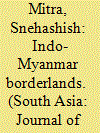

|
|
|
|
|
| Summary/Abstract |
Since the 1990s, the Government of India has undertaken several policy initiatives to facilitate cross-border flows. Such initiatives can be read as an effort to transform ‘battlefields into marketplaces’. This paper examines the rise of the border town of Champhai, located on the India-Myanmar border in the state of Mizoram in Northeast India. The formation of a new urban centre in a frontier region based on border trade reveals different dimensions of transition in Northeast India’s borderlands. The paper explores two key themes: how border trade, comprised of legal and illegal flows, has transformed Champhai into Mizoram’s third-largest city, and how increasing trade across the border reorients the interethnic dynamics with strong implications for ethnic and citizenship politics in Mizoram. The paper concludes by highlighting the different aspects discussed in the article that would determine the borderland dynamics in Mizoram.
|
|
|
|
|
|
|
|
|
|
|
|
|
|
|
|
| 8 |
ID:
109023
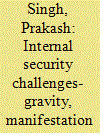

|
|
|
| 9 |
ID:
050839
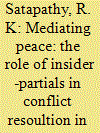

|
|
|
| 10 |
ID:
118449
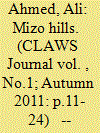

|
|
|
| 11 |
ID:
060140
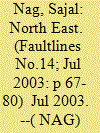

|
|
|
| 12 |
ID:
146850
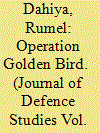

|
|
|
|
|
| Contents |
Operation Golden Bird, conducted along the Indo-Myanmar border in the North-Eastern state of Mizoram under the aegis of 57 Mountain Division (57 Mtn Div) in April–May 1995, has often been portrayed as a joint operation between the armed forces of India and Myanmar. In reality, however, this operation was planned and executed by the Indian Army alone, with troops ex 57 Mtn Div and those under operational control of Headquarters Inspector General, Assam Rifles (North) or HQ IGAR(N). The Mizoram police was excluded from the operation, at least in the initial stages. That the Myanmar Army also got involved in the operation was not by design on any side.
|
|
|
|
|
|
|
|
|
|
|
|
|
|
|
|
| 13 |
ID:
129318
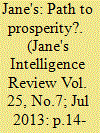

|
|
|
| 14 |
ID:
130695
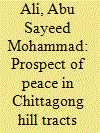

|
|
|
| 15 |
ID:
103564
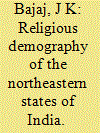

|
|
|
| 16 |
ID:
129067
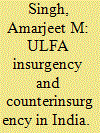

|
|
|
|
|
| Publication |
2014.
|
| Summary/Abstract |
Assam is a land of different cultural groups. Prior to the advent of the Ahoms, the Mongolian people from Thailand, in the 13th century, different regions of Assam were ruled by different dynasties such as Plas, Koches, Kacharis and Chutiyas. The Ahoms invaded Assam in 1236. The land was named "Asom" by the Ahoms (Assam is its an glicised form). Down the line, they have assimilated into the culture of this land.' The Burmese invaded Assam in 1818 and the Ahorns rulers could not stop them. Thus, the British started interfering in the politics of Assam. Assam came under British rule after the Treaty of Yandabo signed between the Burmese and the British in 1826. In 1838, Assam was amalgamated with Bengal. Assam became a province in 1874. In 1905, Bengal was partitioned; Assam was also amalgamated with eastern part of Bengal. In 1912, Bengal was reunited; again, Assam became a province. After the partition of India
and Pakistan in 1947, Sylhet district of Assam (leaving Karimganj to India) was transferred to Pakistan. Finally, Assam became a state of India in 1950. Down the line, the states of Nagaland, Meghalaya, Mizoram and Arunachal Pradesh were created out of Assam. With a population of about 31 million (Indian Census 2011), Assam is one of the most ethnically and linguistically diverse states of India. Assam has been witnessing different kinds of political movements of varying scale ranging from the movement which sought to establish an independent state of Assam to the formation of new states (provinces) within India? Thus Assam has been the victim of violence unleashed by different insurgent groups in which two of them have been banned by the government for seeking
|
|
|
|
|
|
|
|
|
|
|
|
|
|
|
|
| 17 |
ID:
056504
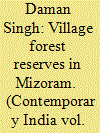

|
|
|
| 18 |
ID:
031412
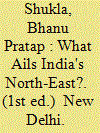

|
|
|
|
|
| Edition |
1st ed.
|
| Publication |
New Delhi, Suruchi Sahitya, 1980.
|
| Description |
104p.hbk
|
|
|
|
|
|
|
|
|
|
|
|
Copies: C:1/I:0,R:0,Q:0
Circulation
| Accession# | Call# | Current Location | Status | Policy | Location |
| 019250 | 954.1/SHU 019250 | Main | On Shelf | General | |
|
|
|
|
| 19 |
ID:
171866
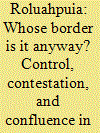

|
|
|
|
|
| Summary/Abstract |
The implementation of the Look East Policy (LEP) ─ now the Act East Policy ─ in the 1990s signaled a marked shift in India’s economic policy aimed at transforming its northeastern region from a peripheral frontier to an economic corridor. The regional focus of the policy commonly appears in references to the northeast region as a whole and the policy suggestions are centered on ending the region’s isolation and underdevelopment. This paper looks at how the inhabitants of a borderland village on the Mizoram-Myanmar border maneuvered themselves in response to the economic drive for the border opening intertwined with the extension of state rule and control. The paper shows how the agenda of the state and the local communities, rather than being in opposition, often converged with local community interests when it came to enhancing trade and liberalizing movement. These factors further served to re-shape ways of identification and belonging as well as everyday trade, commercial transactions, and nationhood. Against this backdrop, the paper engages with everyday borderland lives to examine how change through the policy was mediated upon the interface of competing state and non-state agents as well as local communities.
|
|
|
|
|
|
|
|
|
|
|
|
|
|
|
|
|
|
|
|
|